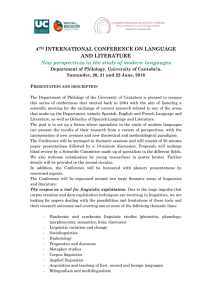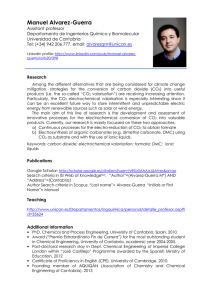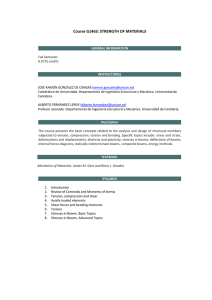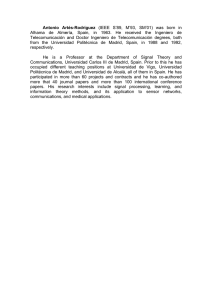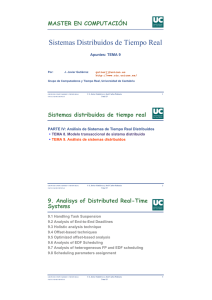AFDX networks
Anuncio
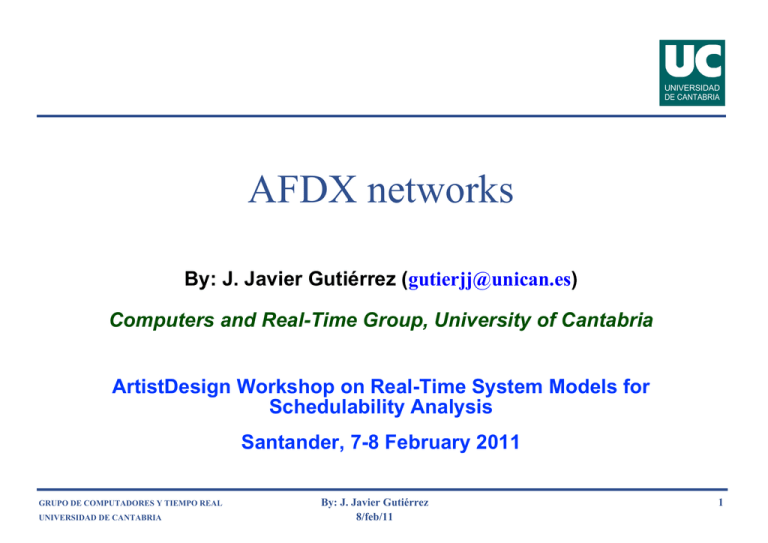
UNIVERSIDAD
DE CANTABRIA
AFDX networks
By: J. Javier Gutiérrez (gutierjj@unican.es)
Computers and Real-Time Group, University of Cantabria
ArtistDesign Workshop on Real-Time System Models for
Schedulability Analysis
Santander, 7-8 February 2011
GRUPO DE COMPUTADORES Y TIEMPO REAL
UNIVERSIDAD DE CANTABRIA
By: J. Javier Gutiérrez
8/feb/11
1
Introduction to AFDX networks
UNIVERSIDAD
DE CANTABRIA
AFDX (Avionics Full Duplex Switched Ethernet) is a
communications network defined in the ARINC-664, Part 7
standard:
• point to point full duplex Ethernet links (redundant)
• special purpose switches with preconfigured routing
• two main types of communication ports:
- Sampling Port: the arriving message overwrites the current
message stored in the buffer
- Queueing Port: the arriving message is appended to a FIFO queue
• UDP/IP protocol is used for transmission
• traffic regulation is made in transmission via Virtual Links
GRUPO DE COMPUTADORES Y TIEMPO REAL
UNIVERSIDAD DE CANTABRIA
By: J. Javier Gutiérrez
8/feb/11
2
Traffic regulation in AFDX
UNIVERSIDAD
DE CANTABRIA
Each virtual link (VL) is characterized by two parameters:
• the largest Ethernet frame (Lmax): a value in bytes that can be
transmitted on the VL
• the Bandwidth Allocation Gap (BAG):
- the minimum interval in milliseconds between Ethernet frames
transmitted on the VL
- a power of 2 value in the range [1,128]
Each virtual link has a FIFO queue for all the fragmented packets:
• the same VL can be shared by several ports, tasks or partitions
- It can cause a poor schedulability of the system
• there is no way to prioritize messages on a VL
GRUPO DE COMPUTADORES Y TIEMPO REAL
UNIVERSIDAD DE CANTABRIA
By: J. Javier Gutiérrez
8/feb/11
3
Maximum jitter
UNIVERSIDAD
DE CANTABRIA
The maximum allowed jitter on each VL at the output of the end
system should comply with both of the following formulas:
∑
( ( 20 + Lmax i ) ⋅ 8 )
i ∈ { set of VLs }
MaxJitter ≤ 40μs + ------------------------------------------------------------------------N bw
MaxJitter ≤ 500μs
• Nbw is the speed of the Ethernet link in bits per second
• 40 μs is the typical minimum fixed technological jitter
GRUPO DE COMPUTADORES Y TIEMPO REAL
UNIVERSIDAD DE CANTABRIA
By: J. Javier Gutiérrez
8/feb/11
4
Ethernet frame
UNIVERSIDAD
DE CANTABRIA
64 bytes
7 bytes
1 byte
6 bytes
Start
Destination
Preamble Frame
Delimiter Address
6 bytes
Source
Address
46 bytes
2 bytes
Type
(0x800
IP V4)
IP
Structure
20 bytes
UDP
Structure
4 bytes
AFDX Payload
1 to 17 bytes
Padding
0 to 16
SN
1
Frame
Check
Seq
12 bytes
Inter Frame Gap
8 bytes
1518 bytes
6 bytes
1 byte
Start
Destination
Preamble Frame
Delimiter Address
7 bytes
6 bytes
Source
Address
2 bytes
Type
(0x800
IP V4)
1500 bytes
IP
Structure
20 bytes
UDP
Structure
AFDX Payload
1471 bytes
4 bytes
Frame
SN
Check
1
Seq
12 bytes
Inter Frame Gap
8 bytes
• Lmax should be in the interval [64,1518]
GRUPO DE COMPUTADORES Y TIEMPO REAL
UNIVERSIDAD DE CANTABRIA
By: J. Javier Gutiérrez
8/feb/11
5
Sub-Virtual Links
UNIVERSIDAD
DE CANTABRIA
A virtual link can be composed of a number of Sub-Virtual Links
Each Sub-VL has:
• a dedicated FIFO queue
• a round robin algorithm working over IP fragmented packets
GRUPO DE COMPUTADORES Y TIEMPO REAL
UNIVERSIDAD DE CANTABRIA
By: J. Javier Gutiérrez
8/feb/11
6
Latency in the transmission
UNIVERSIDAD
DE CANTABRIA
If fragmentation is not required and the messages are produced at
a frequency that is equal to or lower than the BAG of the VL:
MaxLatency ≤ BAG + MaxJitter + L T
• LT is the technological latency in the transmission (it should be
lower than 150μs).
If fragmentation is required or messages are produced in bursts,
the latency for packet p (with p-1 packets waiting in the VL FIFO
queue):
MaxLatency ( p ) ≤ p ⋅ BAG + MaxJitter + L T
GRUPO DE COMPUTADORES Y TIEMPO REAL
UNIVERSIDAD DE CANTABRIA
By: J. Javier Gutiérrez
8/feb/11
7
AFDX switch
UNIVERSIDAD
DE CANTABRIA
Transmissions to or from the switch are made using the full
capacity of the physical link
Packets are delivered in a store and forward way:
• the hardware latency of the switch should be taken into account
A new source of jitter appears in the FIFO queue where packets
should wait to be sent to the destination end system
GRUPO DE COMPUTADORES Y TIEMPO REAL
UNIVERSIDAD DE CANTABRIA
By: J. Javier Gutiérrez
8/feb/11
8
Latency in the reception
UNIVERSIDAD
DE CANTABRIA
Once a message is completely received, it is enqueued at the
corresponding AFDX port
• it could potentially overflow
The technological latency of the end system in reception, LR,
should be lower than 150μs
GRUPO DE COMPUTADORES Y TIEMPO REAL
UNIVERSIDAD DE CANTABRIA
By: J. Javier Gutiérrez
8/feb/11
9
Modelling
UNIVERSIDAD
DE CANTABRIA
The model is similar to the one for the analysis of tasks
We consider two types of messages:
• Synchronized:
- the release times of these messages are relative to a general and
common reference of time
- an offset to represent the interval between the start of the MAF
(Major Frame) and the earliest release of the message
• Non-synchronized: messages can be released at any time
GRUPO DE COMPUTADORES Y TIEMPO REAL
UNIVERSIDAD DE CANTABRIA
By: J. Javier Gutiérrez
8/feb/11
10
Modelling (cont’d)
UNIVERSIDAD
DE CANTABRIA
Different types of parameters to model AFDX communication:
• message stream parameters
b
b
b
b
- Mi, pi, Npi, Ni, M i , p i , Np i , N i , Ti, Φi, Ji, Source(σi), Li, Lib
• VL parameters
- BAGj, Lmaxj, SourcePorts(VLj), DestinationPorts(VLj)
• hardware parameters
b
b
- Nbw, LT, LTmin, JTech, LR, L R , L S
• Ethernet frame and protocol parameters
- OEth, OProt, Nmin
GRUPO DE COMPUTADORES Y TIEMPO REAL
UNIVERSIDAD DE CANTABRIA
By: J. Javier Gutiérrez
8/feb/11
11
Latency Model
UNIVERSIDAD
DE CANTABRIA
SENDING END SYSTEM
RECEIVING END SYSTEM
SWITCH
CSend
LVL
AFDX API
Ethernet
Hardware
LTr
LSW
LTr
LRec
CReceive
Ethernet
Hardware
AFDX API
Physical Links
• 5 steps in the communication process
• 2 contention points: queueing in the sending end system (LVL)
and queueing in the switch (LSW)
GRUPO DE COMPUTADORES Y TIEMPO REAL
UNIVERSIDAD DE CANTABRIA
By: J. Javier Gutiérrez
8/feb/11
12
AFDX in MAST-2
UNIVERSIDAD
DE CANTABRIA
• Processing Resources
- Network: AFDX_Link
- Network_Switch: AFDX_Switch
• Scheduling Policy
- AFDX_Policy
• Scheduling Parameter
- AFDX_Virtual_Link
• Schedulable Resource
- Communication_Channel
• Event Handler
- Message_Event_Handler: Message_Delivery, Message_Fork
GRUPO DE COMPUTADORES Y TIEMPO REAL
UNIVERSIDAD DE CANTABRIA
By: J. Javier Gutiérrez
8/feb/11
13
AFDX in MAST-2: Network
GRUPO DE COMPUTADORES Y TIEMPO REAL
UNIVERSIDAD DE CANTABRIA
By: J. Javier Gutiérrez
8/feb/11
UNIVERSIDAD
DE CANTABRIA
14
AFDX in MAST-2: Scheduling Policy
GRUPO DE COMPUTADORES Y TIEMPO REAL
UNIVERSIDAD DE CANTABRIA
By: J. Javier Gutiérrez
8/feb/11
UNIVERSIDAD
DE CANTABRIA
15
AFDX in MAST-2: Scheduling Policy
(cont’d)
UNIVERSIDAD
DE CANTABRIA
AFDX_Policy:
• messages are scheduled through virtual links
• messages are scheduled in FIFO order when they are originated
at an AFDX switch
This policy may only be assigned to a scheduler that has an
AFDX_Link as its host
GRUPO DE COMPUTADORES Y TIEMPO REAL
UNIVERSIDAD DE CANTABRIA
By: J. Javier Gutiérrez
8/feb/11
16
AFDX in MAST-2: Scheduling
Parameters
GRUPO DE COMPUTADORES Y TIEMPO REAL
UNIVERSIDAD DE CANTABRIA
By: J. Javier Gutiérrez
8/feb/11
UNIVERSIDAD
DE CANTABRIA
17
AFDX in MAST-2: Schedulable
Resource
GRUPO DE COMPUTADORES Y TIEMPO REAL
UNIVERSIDAD DE CANTABRIA
By: J. Javier Gutiérrez
8/feb/11
UNIVERSIDAD
DE CANTABRIA
18
AFDX in MAST-2: Schedulable
Resource (cont’d)
UNIVERSIDAD
DE CANTABRIA
DEFAULT_COMMUNICATION_CHANNEL:
• used for communications through AFDX links when the
message is originated at an AFDX switch
• the implicit scheduling policy is FIFO ordering for the messages
GRUPO DE COMPUTADORES Y TIEMPO REAL
UNIVERSIDAD DE CANTABRIA
By: J. Javier Gutiérrez
8/feb/11
19
AFDX in MAST-2: Switch
UNIVERSIDAD
DE CANTABRIA
It is capable of delivering messages arriving at an input port to one
or more output ports
The delivery operations are specified through special-purpose
message event handlers
MAST does not require to define the network topology (it is implicit
in the end-to-end-flow)
It is assumed a shared memory switch in which messages do not
need to be copied
Contention occurs when several messages need to be sent to the
same output port, in which case a queue is used at the output port
GRUPO DE COMPUTADORES Y TIEMPO REAL
UNIVERSIDAD DE CANTABRIA
By: J. Javier Gutiérrez
8/feb/11
20
AFDX in MAST-2: Switch (cont’d)
GRUPO DE COMPUTADORES Y TIEMPO REAL
UNIVERSIDAD DE CANTABRIA
By: J. Javier Gutiérrez
8/feb/11
UNIVERSIDAD
DE CANTABRIA
21
AFDX in MAST-2:
Message_Event_Handler
GRUPO DE COMPUTADORES Y TIEMPO REAL
UNIVERSIDAD DE CANTABRIA
By: J. Javier Gutiérrez
8/feb/11
UNIVERSIDAD
DE CANTABRIA
22
Example: sending a message through a
switch
CPU1
Message
Task1
Task1
Step:
Regular_P
Thread
Fixed_P_P
GRUPO DE COMPUTADORES Y TIEMPO REAL
UNIVERSIDAD DE CANTABRIA
SWITCH
M1
Step:
AFDX Link
Comm_Chan
AFDX Policy
MD1
Message_E_H:
Switch
By: J. Javier Gutiérrez
8/feb/11
UNIVERSIDAD
DE CANTABRIA
CPU2
Task2
M2
Step:
AFDX Link
Default_C_C
FIFO
Task2
Step:
Regular_P
Thread
Fixed_P_P
23
